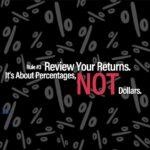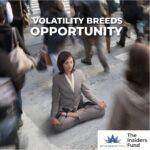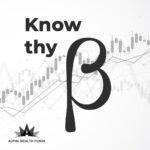When I decided to become a professional investor, I was already a very experienced one. I had been a stockbroker, somewhat of an investment banker, an institutional salesperson, and the founder and CEO of a public company. Still, I had never lived off just my own capital, mainly because I did not have enough of it. So in 2001 when I finally accumulated enough capital, I set aside the time to read many of the most popular investment books of the era. I didn’t read them to find out how to invest, or what can of strategy I would use. I already knew that. What I wanted to know is what the great investors had in common, if anything.
So I read many of the great books with a yellow highlighter in hand. The following is what I found great investors have in common. Let’s start with the pithiest and wittiest of them all, Warren Buffett. The rules are not numbered by order of importance.
Rule 1. Don’t lose Money 
This is perhaps Buffett’s most famous saying, coupled with Rule #2. Buffett is notorious for sticking with an investment. He is famous for saying if you liked it at a higher price where you bought it, you have to like it even more when it’s cheaper.
This actually feels like something the Vice-Chairman of Berkshire Hathaway, Charlie Munger would say. Buffett usually gets the media credit but anyone that has attended the “Woodstock of Capitalism”, the annual Berkshire Hathaway shareholder event, knows that Charlie steals the show.
3. Be Patient – Wait For The Opportunity
Warren Buffett is fond of comparing investing to baseball.
“You don’t have just three strikes to get on base. You can wait for that fat pitch..”
Successful investing requires conviction. Even the best ideas rarely work immediately. Avoid hot tips and rumors.
When I was a stockbroker it amazed me that smart rich people work all year to make money and then turn around and make their investment decisions in minutes and often based on relationships and not merit.
6. It’s Percentages, not Dollars 
This seems too obvious but how many times have you heard people sit around and talk about how a stock went up $10 today or $20 and it was only a half percent. $20 on Amazon is not even 1/2 percent yet people ignore small-cap stocks that go up 5% or more in a day. That’s human nature. It’s percentages that count, not dollars.
7. You have to be able to sleep at night 
VAR (value at risk) A technique used to estimate the probability of portfolio losses based on the statistical analysis of historical price trends and volatility. If you have a portfolio that can go down 20% in a day, you are probably not sleeping well. Jamie Dimon of JP Morgan thinks its horse shit but the firm does it ever night on multiple portfolios. It is statistical too to tell trader how much money they are likely to lose or make if the market goes up or down a certain amount.
8. Beta – the measure of volatility 
- A beta of 1: This means this stock is in line with the market. The market usually refers to the S&P 500 group of stocks
- Beta of less than 1: This means market fluctuations affect this stock to a lesser degree (utility stocks)
- Beta of more than 1: This means this is a volatile stock (technology stocks)
- Negative beta: This means that this stock moves in the opposite direction to the market! If the market’s returns are negative, this stock’s returns will be positive! Gold is usually given as an example even though beta shows that though it is less than 1, it isn’t negative.
- Zero beta:
- This means this stock returns have no relation to the market! Cash in your wallet for example, or a lottery ticket you just bought.
A simple and quick way to find out if you are an aggressive or a conservative investor is to find the weighted average of all stock betas in your portfolio.
- STEP 1: Look up the beta of your individual stocks. It’s easily found on Yahoo finance or other popular stock market quotation sites
- STEP 2: Find the allocation of each stock in relation to your overall portfolio. For example, if your overall portfolio value is $10,000 out of which $5,000 comes from Apple stocks, that’s a 50% allocation for AAPL
- STEP 3: Multiply the individual stock beta with the allocation percentage. For example, the beta for AAPL is 1.38. 1.38 X 50% = 0.69
- STEP 4: Add up all the weighted betas to arrive at your portfolio’s beta
8. Don’t Risk Too Much On One Idea 
The best-laid plans can and often do go wrong. Diversification is key. Over-diversification, though, is a certain path to mediocrity. Beware of margin
10. Beware of Yesterday’s News 
Last year’s winners are just as likely to be this year’s losers. Don’t get caught up in chasing performance.
11. Volatility breeds opportunity 
Often times opportunities occur when people are panicking or reacting to the news.
“You have to keep your head when others are losing theirs. “ Buffett
It does little good to figure out what’s happening today. You need to change your mindset to think about what’s likely to happen tomorrow, six months from now, one year.
Be flexible, open-minded. The market is always telling you something. You may disagree with it but learn to recognize the message. News leaks. Watch price, it often portends the facts on the ground.
Think trades through. Where will you take profits, losses? Have an exit point in mind before you buy or sell.
15. If You Are Unsure, Just Get Out 
It’s easy to get out. Just leave. You can usually get back in when you have more conviction or certainty of outcomes
16. Force Yourself To Trade Against The Consensus 
The consensus opinion is rarely the most profitable pursuit. If 28 out of 30 analysts have a buy on a stock, who is left to buy it then?
Only a fool doesn’t change his mind. Trading the markets is a humbling experience for the best. Start each day anew.
18. Recognize Winners And Losers Fast 
“Don’t cut losses, instead recognize mistakes.” Julian Robertson
“When you knew you were right, there was no such thing as betting too much.” George Soros
“It’s not whether you’re right or wrong, but how much money you make when you’re right and how much you lose when you’re wrong.” George Soros
19. Force Yourself To Buy On Extreme Weakness 
Sell on Extreme Strength. Perhaps the hardest thing to do. Certainly the most important. You will never make money in the market if you are too afraid of losing it.
19. Stay Confident, The Opportunities Never Stop 
Don’t beat yourself up about the one that got away or the idea that went really south. Tomorrow is a new day. Trading the markets is humbling for the best of us.
1 Comment
Add comment Cancel reply
You must be logged in to post a comment.








[…] content is copyrighted by Alpha Wealth Funds. We are happy for you to share our posts but please link back to us for credit. As always all investment ideas can lose money, so invest […]